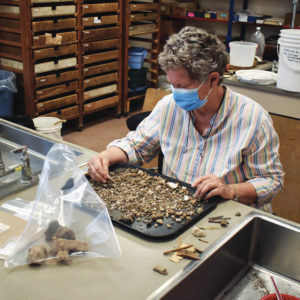If We Knew All the Answers, We Wouldn’t Have to Dig

A letter from the Office of Archaeological Studies Director, Eric Blinman, Ph. D.
In another issue of Friends of Archaeology, I introduced readers to the preliminary work that goes into what might seem to be a simple archaeological project: clearing accumulated debris from against the nineteenth century joists beneath the floor of Room 6 at the Palace of the Governors. The formal plan (required by permitting) is downloadable at www.bit.ly/3wsr3cK. The plan anticipates what we expect to find, but if we really did know what was there, why waste the resources doing the archaeology? Luckily, there definitely is more to learn about Room 6.
We are closing in on the half-way point of the project, where the planning and the excavation are complete, and now we are processing artifacts and samples. Although we recover artifacts continuously in the field, this project was special in that the History Museum wanted the dirt removed from the premises permanently. We couldn't screen deposits as we excavated (too much dust within the unventilated room) and there was no place to screen it and pile it in the courtyard of the Palace. So, the strategy was to fill buckets with the excavated dirt and bring the buckets back to CNMA for processing.
Excavation proceeded with 165 horizontal and vertical proveniences, defined by the joists, the underlying gas line trenches, and the different stratigraphic layers of fill that had accumulated around and between the joists. In some cases a fair amount of fill had accumulated, with up to five buckets required to hold all of the dirt from a single provenience. In other cases (toward the center of the room), there had been little or no accumulation, and a small paper bag was sufficient to recover inter-joist debris without requiring dirt removal.
Isaac Coan, with some help from volunteer Laura Reich, has screened bucket contents through ⅛-inch construction mesh, concentrating the artifacts and bigger resistant dirt clods. Volunteer Kay Henriksen has been patiently working through the collected debris and the screenings, picking out and cleaning the artifacts, while bagging the clods. The clods are important since they are mostly fragments of adobe bricks and mortar, and we will need to describe their nature and volume at various areas around the room perimeter.
The artifacts are interesting, and they keep Kay on her toes. They include lost items that have slipped through the cracks in the floorboards over more than a century, construction trash from several episodes of remodeling and repair, refuse from when the area of the room was part of a corral, and centuries of artifacts that were mixed into both the Fort Marcy era adobes and the Spanish Colonial adobes.
Kay's highlight list so far includes shattered plexiglass from early exhibits in the room, beads (like Mardi Gras beads), buttons, red beans, pins, nails, and food bone. Of singular interest have been fragments of a European clay pipe, mica sheets (some cut), and a foil-wrapped chocolate coin. When the buckets are processed, the formal analysis of the artifacts and construction debris will begin.
The next installment of the Room 6 story will address what we have learned about the room's history.
This article and image are from the Friends of Archaeology Newsletter August 2022.


Connect